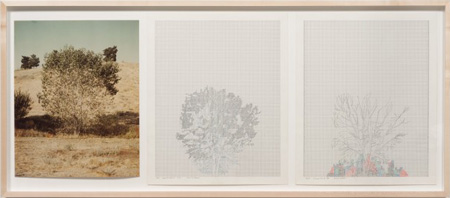
Continuing through October 21, 2012
“In the Shadow of Numbers: Charles Gaines Selected Works 1975-2012” is a heavy walk that viewers must actively question to fully appreciate. While often referenced as a conceptual artist because of his perplexing use of ideas, the work itself is more akin to arts-based research than the early conceptualism of the 1960s. The collected works feel like social science experiments, with the viewer as the subject of study. Overall, Gaines' reputation for making meaning is bolstered in this smart survey because it explores understanding through aesthetics and politically charged language.
On view and dating over the past forty years are the "Explosion," "Randomized Text: History of Stars," "Night/Crimes," "Shadows," and the "Walnut Tree Orchard" series. Some, like the "Walnut Tree Orchard" and the "Shadows" series share systematic similarities, offering us some clues to connective ideas. Other series, like "Randomized Text: History of Stars," require a reorienting of your normal assumptions to pick at the relationships between image and text.
In the recent "Explosion Drawings" (2006-present), Gaines lightly renders individual explosions with smoke blooming softly in the air. The stylized smoke billows upward and changes tone, growing lighter and eventually fading into the white background. The absence of context disorients our view of the subject. Besides the fire and smoke, there isn’t anything else to command our attention, or direct our sense of context. So much so that these drawings may look like smoke emitting from a chimney or volcano from a distance. Neither is there any visual reference to the cause of these explosions, which is intentional because the accompanying text describes an anti-colonialist insurgency. It is the text that produces an emotional reaction and begins to impose meaning. The combination of image and text can be understood as a dissection or study of the relationship between form and content.
On a much more solemn note, the "Walnut Tree Orchard" (1974-2012) series uses a singular subject to create a more complex understanding of trees. Hung as triptychs, each set features a black and white photograph and two ink drawings. The photographs each display a single tree that is centered and quite bare. The photographs are placed on the far left in each triptych, and they gain in complexity from left to right.
The second drawing following each photograph is a tracing of the tree featured in the original photograph. This is an accurate representation that focuses on its contours and shape. The third tree represented in each triptych is called a number drawing. The series features 26 triptychs, and in the third drawing the aggregate of each tree is superimposed on top of one another. Thus in the final series, all the trees are represented in that one image. As the series progresses, so does this third image, becoming less like the single trees represented. It’s an interesting study of representation and experience with a subject.
The readable handwritten text in the series entitled "Randomized Text: History of Stars" (2006-08) is understandable and juxtaposed with images of the night sky by virtue of its placement. The text originates from two books: Gabriel Garcia Marquez’s "Love in the Time of Cholera" and Edward Said’s "Orientalism." The sentences alternate back and forth with no intentionality. Meaning is made through close association, in this case physical. This is a device that Gaines uses again in his "Night/Crimes" (1994-95) series where the night sky is juxtaposed with crime scene photographs. Whether the sky indicates the time or place of the murder is not evident, or even relevant, but a connection is forced.
The key word in summarizing Gaines approach is metonym (or metonymy), which is a figure of speech that is used to identify something that is not called by its name but instead something that is closely connected to the subject.
Published courtesy of ArtSceneCal ©2012
